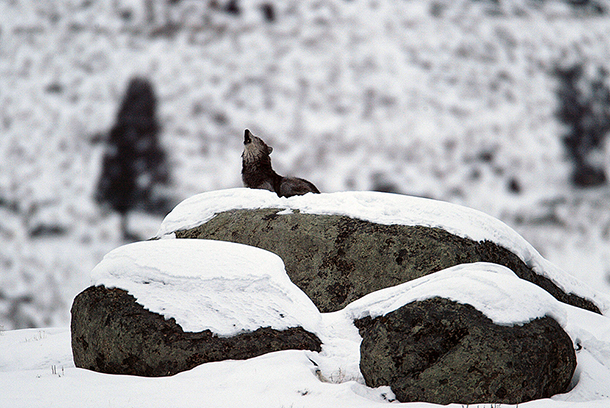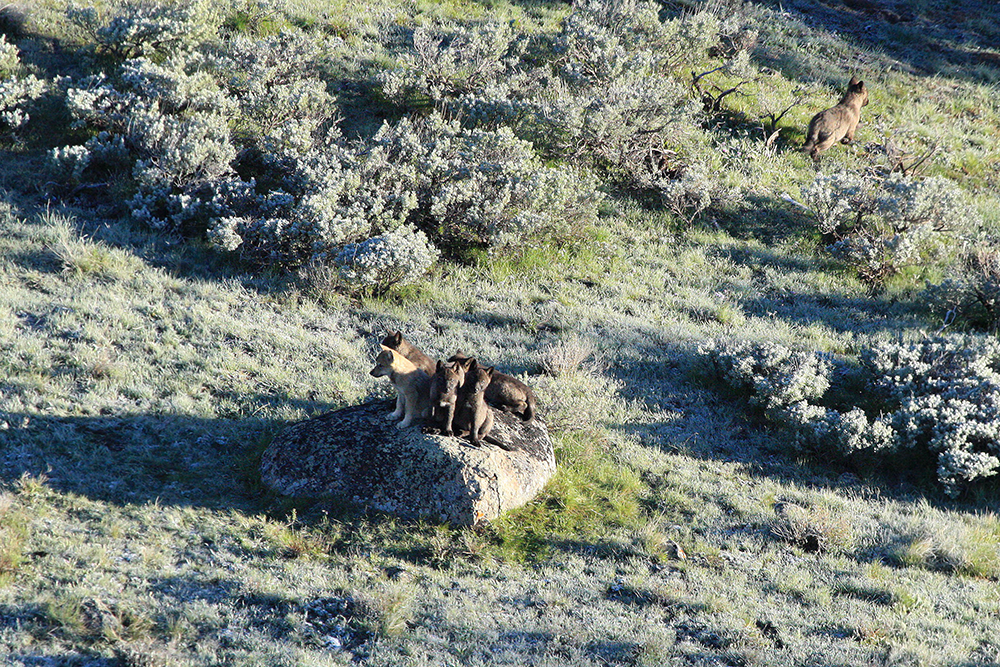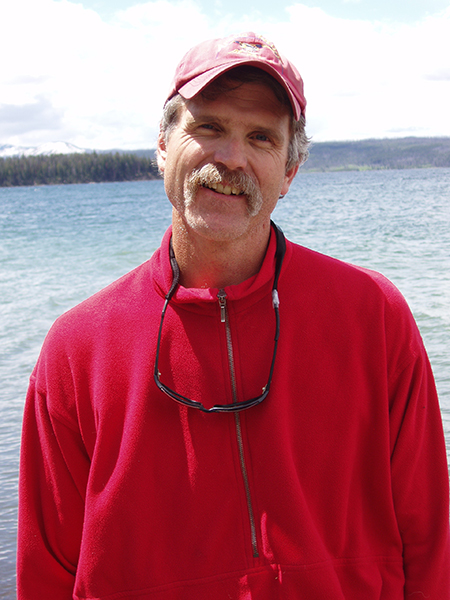
A wolf from Yellowstone's Druid Pack mid-howl (Photo: NPS Photo)
When a wolf howls in Yellowstone’s snowy landscape,
a howling chorus responds. But in the spring, the wolves grow quieter
as they raise pups. Now researchers understand how wolf calls change
with the seasons, and hope to answer the tougher question of what the
howls actually mean. The park’s reporter-in-residence, Jennifer Jerrett,
has the story.Transcript
CURWOOD: Though wolves are under fire in British Columbia, the packs in national parks like Yellowstone give wildlife experts the chance to study many aspects of their behavior. And as Jennifer Jerrett explained, when it comes to howling wolves, scientists say there’s a time for every purpose under heaven.[WOLVES HOWLING]
JERRETT: Researchers in the park have recently discovered that there is a seasonal cycle to those howls.
[HOWLING FADES]
JERRETT: Biologist Doug Smith is the project leader for all of the wolf research that takes place in Yellowstone National Park. He says that if you’re a wolf in Yellowstone, you still howl in the spring…
SMITH: … but you howl less, you only howl when you need to and you’re only howling to your packmates. As the summer grows old you start howling more and more, and so now you start howling to your neighbors, your enemies, and it increases through the fall and winter. That’s the seasonal cycle.

Wolf pups in spring (Photo: NPS Photo)
JERRETT: The seasonal cycle peaks in February, which tracks right along with the breeding season in Yellowstone. And there’s a lot of howling back and forth between neighboring or rival wolf packs.
SMITH: Wolves are ferociously territorial, and so they howl to others to say ‘Hey I’m here, stay out.’
JERRETT: But in the spring, when wolves start establishing den sites to raise pups, everything changes.

You never forget your first wolf in the wild. (Photo: NPS Photo)
SMITH: So what appears to be happening during the denning season is that howling for territorial purposes goes away. You stop communicating to your neighbors. So what we’ve noticed what doesn’t go away is howling to your packmates, to your family members.
JERRETT: So while there’s less howling overall in the spring and summer, the call-and-response that does go on is almost entirely within pack. Doug has been studying wolves for 35 years. He explains what might be happening.
SMITH: In the winter the pack’s all together and they travel widely, they go everywhere. When they have those pups, wham! An anchor gets thrown in, they become your ball and chain. And wolves need to carry on their business, but they also need to care for their pups. So they leave the pups at the den and they split up. Well, that presents a problem of how you coordinate activities, how do you communicate, how do you find each other. Well, you howl.
[WOLVES HOWLING]

Doug Smith is a wolf biologist and the project leader
for wolf restoration program in Yellowstone National Park. (Photo: NPS
Photo)
JERRETT: The only way that the research team working in Yellowstone was able to tease apart this seasonality – more howling that tends to be territorial in the fall and winter, less howling that’s more family-focused during spring & summer -- is because when it comes to wolf research, Yellowstone’s landscape is unique. There’s a lot of open country in the park. So you can see the wolves… see what they do when they howl. And this is what provides the context for understanding howling.
CURWOOD: That’s Jennifer Jerrett from Yellowstone National Park, where she’s reporter in residence.
Links:
More on the wolves in Yellowstone via National Park Services
Montana State University Library's Acoustic Atlas
Yellowstone Association
The Yellowstone Park Foundation
source


No comments:
Post a Comment